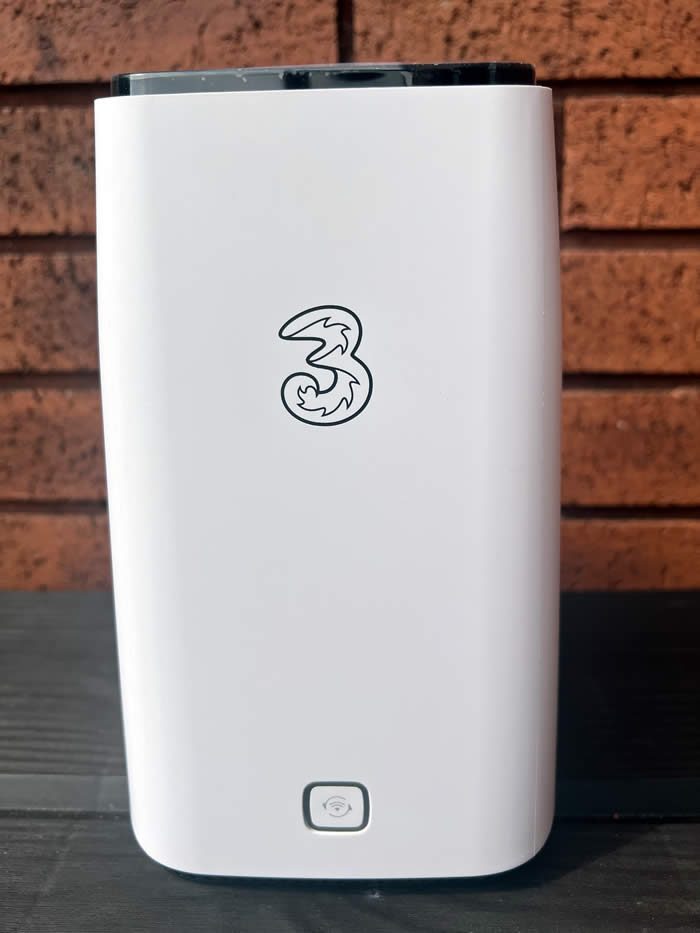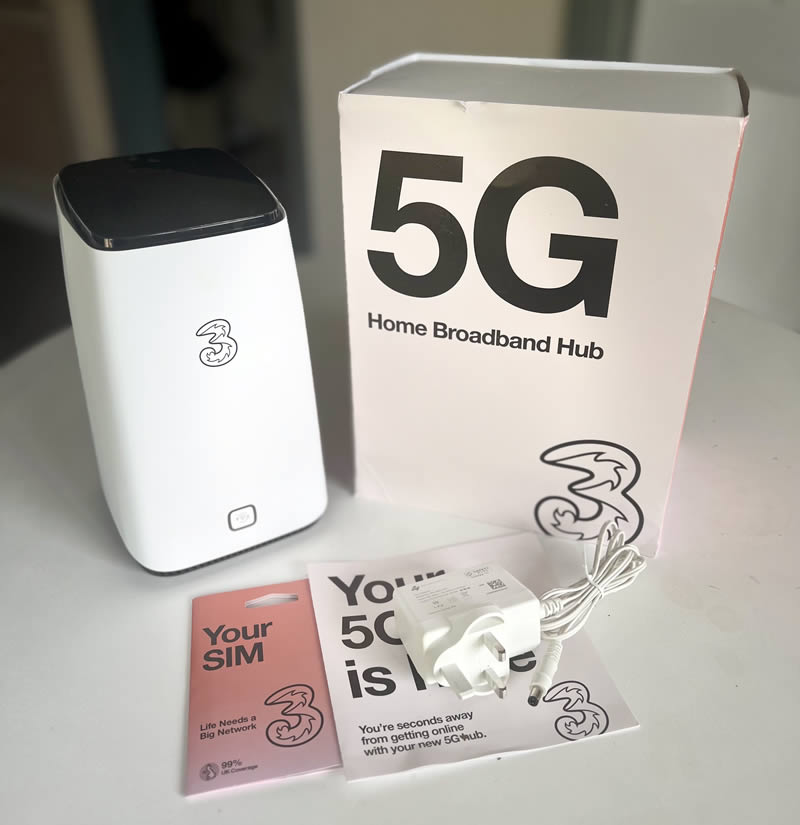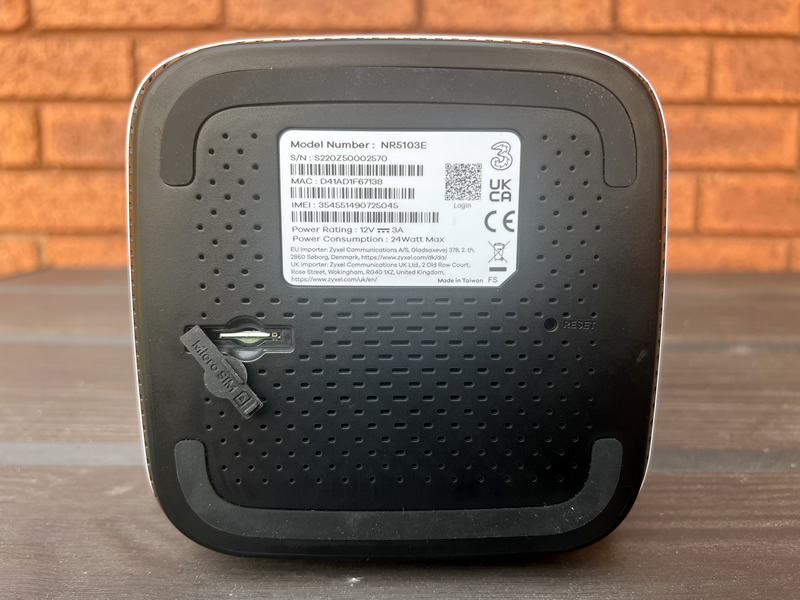
|
Pros |
Cons |
|---|---|
|
Very fast |
Three’s 5G can’t make the most of the hardware |
|
Multiple Ethernet ports |
No antenna ports |
|
Unlimited data at a competitive price |
|
Verdict
The Three 5G Hub is an excellent way to get 5G broadband at home. While it doesn't stand out much from some rivals, it's very fast and provides good coverage to your home.
Three 5G Broadband
Three 5G Broadband
Three 5G Broadband
- Full Review
- Specifications Specs
Full Review
If you’re after 5G home broadband then your options are limited at the time of writing – not many networks offer it, and they typically only offer one router each.
Take Three – if you want 5G home broadband on this network, then you can only get it with the Three 5G Hub (also known as the Three 5G Home Broadband Hub) currently, but that needn’t be a problem, as this is a very good device.
From its fast speeds (like all 5G routers) to its simple setup, along with other useful specs and features, most buyers should be happy with this, but to find out more – and whether it’s the right router for you – read on below.
Design

The Three 5G Hub is actually a ZTE MC888 to give it its full name. It’s a tall, curvy box, it comes only in white, and it has dimensions of 87 x 225 x 154.5mm.
Despite being made by ZTE, the only big brand name you’ll see on the device itself is Three’s, but that’s not uncommon, with networks often rebranding hardware from other companies.
Indeed, this isn’t the first Three 5G Hub. Previously the company had a device with the same name, which under the surface was a Zyxel NR5103E. But that’s no longer available, and this new model is a solid replacement.
In any case, there aren’t many other details to note – there are a few indicator lights on the front and a few ports on the back, but basically, it’s a very plain router, as most such things are.
It’s not likely to either offend or excite from a design perspective, which is exactly what we want from a 5G router.
Setup

Like most 5G home broadband devices, the Three 5G Hub is essentially plug and play – just plug it in and it will start working. That means no engineer visits and no need for a landline, the latter of which means you can potentially save money, and the former means you can save time in getting your broadband up and running.
Of course, getting the Three 5G Hub configured involves a bit more than just plugging it in – you’ll likely want to change the security settings and potentially the Wi-Fi name, but that too is simple and speedy to do.
And once it’s configured you can easily just plug the Three 5G Hub in at a new address if you move house or want to take it with you somewhere else – though you’ll need 5G coverage to make the most of it.
Performance and speeds
| Download speeds (Mbps) | Upload Speeds (Mbps) | Latency (ms) | |
|---|---|---|---|
| Average | 419.6 | 18.3 | 29 |
| Maximum | 633.5 | 36.1 | 34 |
| Minimum | 122.7 | 11.8 | 26 |
The Three 5G Hub supports download speeds of up to 3.8Gbps, and upload speeds of up to 250Mbps.
However, in reality you probably won’t get speeds anywhere near that in most cases. Average speeds vary by location, but Three claims that average speeds should be 150Mbps for at least 50% of 5G broadband customers, between the peak hours of 8am and 10pm.
That’s great, but still a long way short of the theoretical maximum – though note that Three claims that its network tops out at 1Gbps with this device, so even at the top end, the hardware is capable of more than Three’s network will currently allow for.
Still, that does mean the Three 5G Hub is future-proofed, and those speeds are significantly faster than most 4G home broadband connections, as well as competing with fibre broadband.
While you can get average speeds of 1,130Mbps if you opt for a Virgin Gig1 fibre connection, that’s not available in most places. Indeed, the average fibre broadband connection is far slower than you can potentially get with the Three 5G Hub. BT Broadband’s most widely offered fibre deals for example have average speeds of between 35Mbps and 73Mbps.
Features and software
The Three 5G Hub has just about all the features you’d expect and then some. It supports both 2.4GHz and 5GHz Wi-Fi, along with Wi-Fi 6, and it has two Ethernet ports for wired connections.
Plus, the Three 5G Hub can get up to 64 devices connected to the internet at once. That should be far more than almost anyone would need, and it’s in line with most but not all rival devices.
The only area where it’s particularly lacking is in the absence of any external antenna ports. That said, if you can’t get a strong signal in your home, Three has an alternate product anyway, dubbed the Three 5G Outdoor Hub.
Alternatives
The two main alternatives to the Three 5G Hub are the 5G Vodafone GigaCube and the EE Smart 5G Hub.
The EE Smart 5G Hub is somewhat similar to the Three 5G Hub but it can get over 100 devices online. However, it also typically costs more.
As for the Vodafone GigaCube 5G, that also has largely similar specs, including support for 64 simultaneous connections, but its theoretical speeds are lower – though still higher than any UK network can currently manage, so that’s not really a factor.
All three devices also have two Ethernet ports and a fairly plain, mostly white design.
Beyond the hardware differences, you should be selecting based on price, coverage, network speeds, and data allowance.
We’ll get to Three’s plans below, but they’re very competitive. Three’s 5G coverage is also growing rapidly, though of course that doesn’t mean you’ll have it in your home. At the time of writing if you have any 5G coverage it might be limited to just one network, so that by default will be the one to go for if you want 5G home broadband.
If you do have a choice though, then it’s worth noting that Three’s 5G is frequently faster than rivals. For example, a September 2024 report from Opensignal found that Three’s average 5G download speed was the highest, at 208.9Mbps.
Similarly, a report from RootMetrics covering the first half of 2025 found that Three’s median 5G download speed was the second highest at 217.3Mbps, and its 95th percentile 5G download speed (meaning the ‘best case’ 5G speeds) was the highest at 916.8Mbps.
These were tests of smartphones, but similar results would likely be found with 5G home broadband routers. You can read more about each network’s 5G speeds in our ‘how fast is 5G?’ guide.
Plans
At the time of writing, Three offers its 5G hub on the choice of a 1-month, 12-month, or 24-month contract. Either way you get unlimited data, with 24 months coming in at £21 per month and 12 months at £24 per month, while a 1-month plan costs £28 per month, and there’s no upfront cost with any of these.
We’re fans of the simplicity of the plans on offer. While some networks offer a range of plans with differing data limits, the fact is that home broadband should be unlimited, so there’s little need for that. The pricing here is also very competitive.
Conclusion
The Three 5G Hub is an excellent 5G home broadband router. It’s fast, affordable, designed for maximum coverage, and has handy Ethernet ports.
We have no major complaints, so if you have 5G coverage at your home on Three, then this is a superb option and a strong alternative to fibre broadband. That said, price aside the rival devices from EE and Vodafone are similarly accomplished.
Three 5G Broadband
Three 5G Broadband
Three 5G Broadband
Specifications
- Dimensions (mm): 87 x 225 x 154.5
- Modem: 5G
- Colours: White
- Ethernet ports: 2 Ethernet ports
- Download speeds: Up to 3.8Gbps
- Upload speeds: Up to 250Mbps
- Wi-Fi specs: Dual-band 802.11a/b/g/n/ac/ax (Wi-Fi 6) 2 x 2 MIMO
- External Antenna: N/A
- Power: Mains powered
- Launch date: Out now
50% off Lyca Mobile’s Pay As You Go plans
Lyca Mobile’s cheap Pay As You Go deals include roaming and international minutes.














